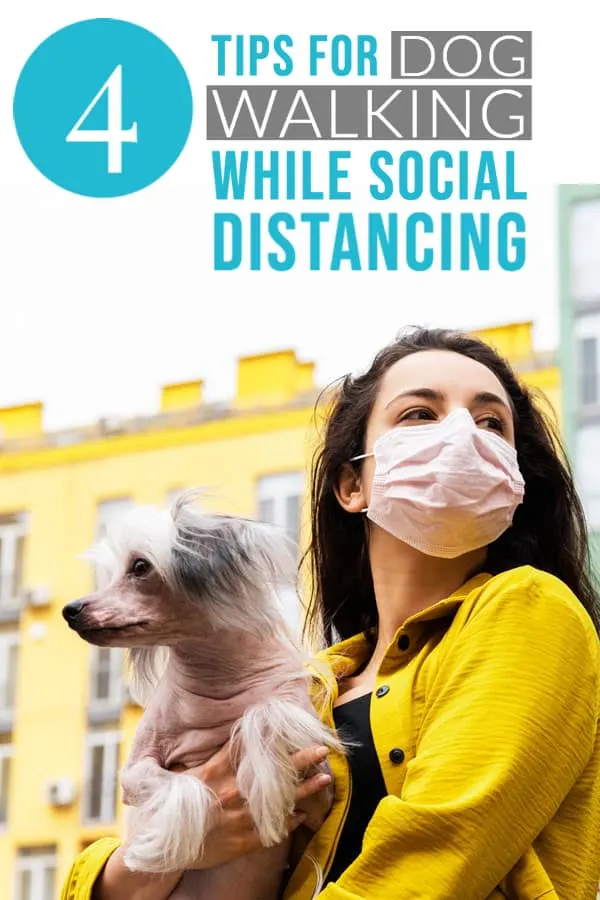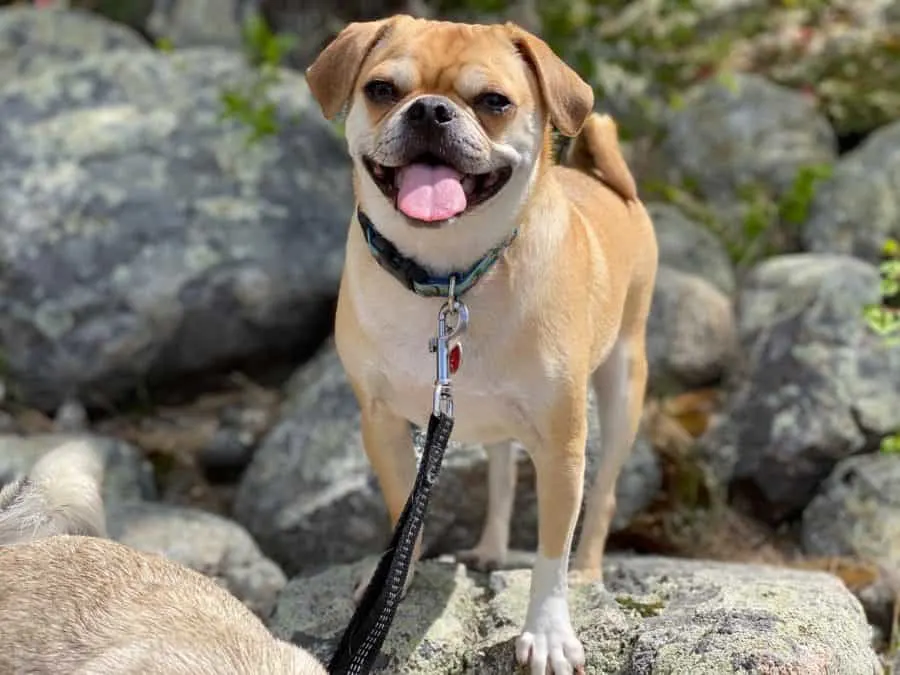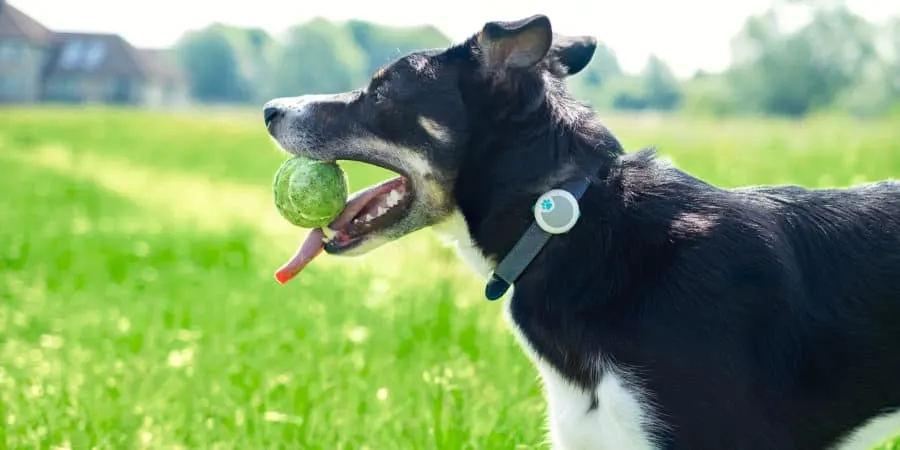By Certified Dog Trainer Mikkel Becker in collaboration with Sure Petcare Technology Products

With all the social distancing rules for humans, walking your dog may seem crazy and out of control these days. Here are four easy-to-apply solutions to help ease frustration and up the loose leash finesse, making outings more fun for you and your canine companion.

Use a front or multi-point attachment harness
To begin, an easy fix to help gently deter pulling and increase control over the dog’s direction and pace: walk your dog on a harness that offers a leash attachment at the front of the dog’s chest.
The chest attachment helps deter pulling by adhering to the dog’s center of gravity, naturally nixing excessive leash pulling.
The chest attachment also increases directional control. The dog can then be guided around to face its human or to move in another direction when necessary.
In contrast, when using a collar or back attachment harness, the dog can still strain and face in the opposite direction from the way they are moving. This makes it more challenging to control the dog’s momentum. It also heightens the likelihood of uncontrolled reactions at the end of the leash.
In addition to the front clip harness, there are also harnesses with multiple attachment points like the center of the chest or top of the dog’s back. And, with a double ended leash with two clasps, the leash can also be attached to multiple points at once for added control and closeness.
Multiple attachment points allow for extra options that can be adjusted depending upon the situation and the dog’s training progress.
For instance, a dog can be walked using the front, center chest attachment in situations where they are more apt to pull (like when around people and other dogs).
But, when allowed to explore at a distance on a longline, or when tired near the end of the walk, the leash may be secured on the top of the dog’s back.
Or, when needing extra control in more difficult to navigate areas, like walking near traffic or in an apartment building going up stairs or in an elevator, the double ended leash attached to multiple points keeps the dog closer for added guidance.

Carry a fixed length leash
Another way to encourage more pleasant leash walking experiences is to add a fixed length leash, rather than an extendable, retractable leash.
A fixed length leash limits the distance the dog can venture before the slack is lost and the leash goes tight.
This allows the human to offer ongoing feedback teaching the canine to walk with a slight slack on the lead.
When the dog hits the end of the fixed length lead and the leash goes tight, forward progress stops.
Much like a red light, a tight leash puts a temporary stop on the walk. When the leash is slack and the dog turns its head or body towards their person, even for a moment, the green light turns back on and the walk ensues.
When the dog consistently learns that the tight leash puts a stop on the walk, over time the dog learns that the fastest way to get to where they want to go isn’t pulling, but rather, walking closer to their pet parent while on a loose lead.
Another alternative to the fixed length leash (for those that have difficulty holding onto the lead) is to consider a fixed length leash with a bungee-like stretch material that helps reduce the impact when the dog hits the end of the leash.
While there are some drawbacks, such as the dog gaining some distance at the end of the leash through pulling, on the flip side, the dog parent gains increased ability to safely hold onto the end of the leash without risk of injury.
Or, another option for hands free walking is to consider a waist attachment, a standard length leash that also has a fast release buckle for an emergency (also available with slight stretch to reduce impact).
Ideally, avoid retractable leashes, as they offer little control of the dog and increase the tendency to pull. But, if that’s all you have, ensure the leash is used in a responsible way like in an open space that’s well away from other people and dogs.
Under these circumstances, you should hook the leash to a back clip harness, rather than a front clip harness, to make a clear distinction to the dog when it’s okay to move forward with slight tension on the leash, without the walk temporarily ending when they do.
Or, as an alternative, use a longline, which comes in lengths of 15, 20 and 30 foot lengths, to offer your dog additional space to roam and explore open areas.
Carry a treat pouch
Dogs often appear distracted and disinterested in the human attached at the other end of the leash, because they haven’t learned that tuning in and checking in with their people while out on walks is worth their effort.
The more a behavior is reinforced with rewards, the more likely the behavior will happen again in the future.
In particular, when it comes to walks, the more the dog is rewarded with tasty treats, or even favorite toys, for moments of connection, the more likely they’ll stay close and check in more often with their humans.
Always have a variety of tasty treats on hand in a treat pouch, or even a pocket to be ready to reinforce any reward-worthy moment.
At first, this may be as simple as the dog orienting their body or gaze in their person’s direction, even for a moment.
Opportunity to be released to sniff areas of high interest, such as a scent laden bush or fire hydrant, are also ways to reinforce and increase calm behavior, like checking in with their guardian.
As with all training, it’s essential to educate the human as well as the canine. For that reason, ensure that all designated dog walkers are consistent in keeping with the guidelines that are focused on improving the dog’s behavior.
Consistency is key for successful training and provides fertile ground for the dog to continue achieving.
Finally … make sure that the walk is good quality
A good walk is essential to a dog and ensuring that you are following the etiquette in today’s circumstances, is key.
But the latest technology in the form of activity trackers are valuable tools for measuring and monitoring important indicators of your pet’s physical and emotional well-being.
A monitor, like the light weight Sure Petcare Animo, tracks the duration and intensity of your dog’s physical activity and provides the calorie burn for that day. Such information allows for easy insight and potential adjustment of the dog’s nutritional needs to gain or maintain a healthy waistline.
You can also set goals for your dog’s daily activity and compare the ongoing average to help make adjustments to get the dog into better shape by creating a sustainable exercise routine.
Related: Our Review of the Sure Petcare Animo
According to veterinarian and author of Fitness Unleashed, Dr. Marty Becker DVM recommends working towards fitness goals by increasing the dog’s current activity level by 5 percent to 10 percent each week.

By monitoring and adjusting the dog’s daily move goal, the canine has the opportunity to get in shape and build up muscle endurance over time.
Advanced animal monitors like Animo, (which easily attaches to your dogs collar) also compare different elements of the dog’s normal day to alert owners to changes in quality of rest, activity, excess shaking, scratching or barking. These behaviors can all indicate underlying issues that may require a visit to the vet.
The monitor’s on-going daily record also allows for comparison to see patterns and progression over time. For instance, the activity tracker can monitor dogs that bark at other dogs on leash and see the progress after incorporating different training techniques to improve the dog’s reaction when encountering other dogs.
Or, there may be insights into why a dog is more on edge and anxious on certain days. For instance, Animo tracks the dog’s quality of sleep. And, just like us, on days when the dog is sleep deprived, they may be more on edge, irritable and likely to react negatively towards other dogs than on days when they are well rested.
Following these tips will make walking your dog a more enjoyable experience in these times of social distancing.
You Might Also Like
How to Transition Your Dog to the “New Normal”
How to Make Your Dog Feel Secure and Safe During Anxious Times
Worried About Separation Anxiety When You Return to Work?
- Selecting the Best Online Emotional Support Animal Letter Service - December 14, 2023
- How to Store Dog Toys –10 Solutions to Organize Those Toys! - July 7, 2022
- Best Practices to Puppy-Proof Your Home - June 27, 2022
